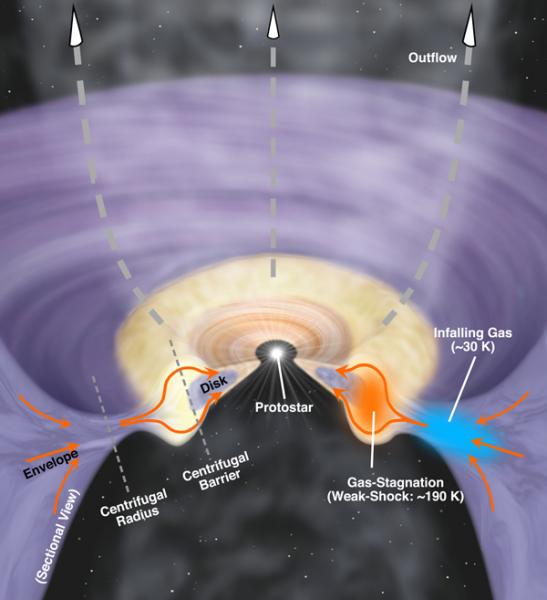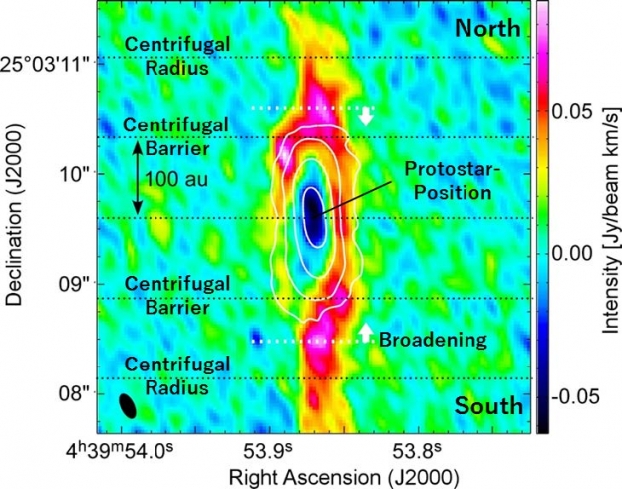ALMA reveals the curious geometry of a proto-star
One of the great mysteries of astrophysics lies in understanding the different stages of formation of a star such as ours. How a star like the Sun emerged from the gravitational collapse of a molecular cloud is still a mystery in many ways. The gas in the parent cloud is rotating and has angular momentum. As it collapses, the gravitational force becomes dominant over the centrifugal force due to the rotation. It is the angular momentum that, within a certain radius called the centrifugal barrier, prevents this collapse.

Interferometry is the only way to achieve sufficient spatial resolution to find out what is happening on a small scale. A team of Japanese (led by Nami Sakai) and French researchers from the Institut de Planétologie et d’Astrophysique de Grenoble and the Institut de Recherche en Astrophysique et Planétologie de Toulouse brings new bricks to this understanding of the stellar formation process thanks to radio observations made with ALMA (Atacama Large Array Millimeter), a 66-antenna interferometer located in the Atacama Desert in Chile.
This team is studying a protostar, called L1527, located in the Taurus Molecular Cloud, a star-forming region about 450 light-years from our Sun, which has a rotating inner disk (as seen by the slice) buried within its parent cloud of gas and dust. ALMA observations have made it possible to observe it with a precision, so far unequalled, of several dozen astronomical units (1 AU = distance Sun-Earth). This same team had previously highlighted the presence of a transition zone between the outer envelope and the inner protoplanetary disc (which later formed planets).
This zone had been characterized thanks to the ALMA observation of the emission of certain molecular species such as SO and c-C3H2. The new data relate to the observation of CCH and SO and provide a better understanding of the collapse of the envelope of a protostar. The centrifugal barrier corresponds to a zone where particles stop their course towards the centre of the protostar. Observations show an accumulation of material just outside this barrier. A significant part of the angular momentum is thus lost by this “bottling” and the shock wave it causes leads to a heating of the gas.

The observed behaviour is in accordance with a ballistic model, not requiring magnetic or other forces, in which the gas particles behave like simple projectiles. Further observations at high spatial resolution are planned to refine the understanding of these dynamics. This is a further step towards understanding the evolution of our own solar system.
These results were published in the journal MNRAS (Monthly Notices of the Royal Astronomical Society) edited by Oxford University Press. The authors of this study are Nami Sakai,Yoko Oya, Aya E. Higuchi,Yuri Aikawa, Tomoyuki Hanawa, Cecilia Ceccarelli, Bertrand Lefloch, Ana López-Sepulcre, Yoshimasa Watanabe, Takeshi Sakai, Tomoya Hirota, Emmanuel Caux, Charlotte Vastel, Claudine Kahane.
Further Resources
- Scientific article : Vertical Structure of the Transition Zone from Infalling Rotating Envelope to Disk in the Class 0 Protostar, Sakai, Nami et al., IRAS04368+2557.
- ALMA Observatory Press Release : ALMA Reveals the Structure of a Low-Mass Protostar System
IRAP Contacts
- Charlotte Vastel, charlotte.vastel@irap.omp.eu
- Emmanuel Caux, emmanuel.caux@irap.omp.eu






